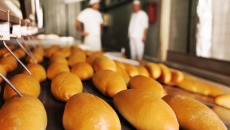Unwanted coffee beans offer natural preservatives
the beverage - may offer extracts with antioxidant potential to
extend the shelf-life of food products, suggests new research from
India.
"The high antioxidant potential of the methanol extract of low-grade coffee beans is due to the presence of phenolic compounds including chlorogenic acids, which make them more suitable as a source of natural antioxidant and their utility can be explored in food industry," wrote the authors from the Spices and Flavour Technology Department at the Central Food Technological Research Institute in Mysore.
The study is published in the Elsevier journal Food Research International .
Interest is growing in plant-derived food additives as replacements to synthetic antioxidants like butylhydroxyanisole (BHA) and butylated hydroxytoluene (BHT) to slow down the oxidative deterioration of food.
Indeed, according to a 2003 report by Frost and Sullivan, the synthetic antioxidant market is in decline, while natural antioxidants, such as herb extracts (particularly rosemary), tocopherols (vitamin E) and ascorbates (vitamin C) are growing, pushed by easier consumer acceptance and legal requirements for market access.
This natural antioxidant range could potentially include the extracts from low-grade coffee beans, representing between 15 to 20 per cent of coffee production, report the researchers behind the new study.
The researchers, led by L. Jagan Mohan Rao, looked at the potential of different solvents (hexane, chloroform, acetone and methanol) to obtain antioxidant-rich extracts from unwanted coffee beans.
They report that the highest yield was obtained by methanol, with 12 per cent, followed by hexane at eight per cent.
The methanol extract also came out on top in terms of radical-scavenging activity, with 92.5 per cent. "
Further, the methanol extract showed antioxidant activity (58 per cent ) at 100 ppm concentration, while the other extracts, acetone, chloroform and hexane exhibited 44, 28, and 14 per cent , respectively, at the same concentration ," stated the researchers.
The methanol extract, highlighted by the researchers as the most promising extract, reportedly contained 21.9 per cent total phenolics, 34.2 per cent chlorogenic acid, and 8.25 per cent caffeine.
"This study provides evidence for the antioxidant potential of low-grade (defective/rejected) coffee beans and their extracts," wrote the researchers.
"Incorporation into food systems may require further studies on other characteristics such as carry through effect, toxicological aspects and standardization of dosage to be used," they added.
"Since the substandard coffee beans are not suitable for making coffee beverage, presence of phenolic compounds and chlorogenic acids in a considerable quantity make them suitable as a source of antioxidant/oxygen scavenger/free radical scavenger conserve/compounds.
These conserves/compounds can be tried for preservation in different food systems," concluded the Indian researchers.
The research taps into the growing trend for sourcing natural antioxidants from waste sources, and then using them as nutraceutical or functional ingredients.
Indeed, researchers taking part in the EC CRAFT project FAIR 98-9517 reported in 2006 the practical, economic, and industrial viability of waste products from juice production, waste from the canning industry, or remains from the harvesting of 11 different fruits and vegetables.
The study focussed on two important aspects for the extracts: Firstly, if the plant waste extracts have potential as antioxidants compared to established ones, and, secondly, if the research could lead to practical and economic applications.
Initial screening of red beet, apple, strawberry and pear residues from juice production; tomato, artichoke and asparagus from the canning industry; chicory, endive, cucumber and broccoli remains from harvesting; and golden rod herb and woad herb extracts showed that all of wastes yielded polyphenols.
The advantages of using these natural antioxidants could offer important opportunities for food preservative producers.
Source: Food Research International (Elsevier) Volume 41, Issue 1, 2008, Pages 96-103 "Antioxidant potential of low-grade coffee beans" Authors: K. Ramalakshmi, I. Rahath Kubra, L. Jagan Mohan Rao















